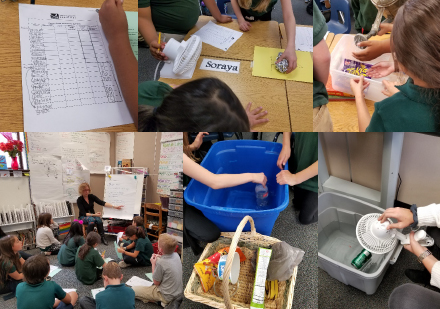K-5 STEM Grant Pairs Environmental Engineering and Español
Not many kids grow up wanting to be a Waste Warrior. But, after spending time in Kristen Jackson’s 4th grade class at Mt. Rose Elementary, everyone’s hooked.
“What I am most amazed about the units that I have been able to purchase with the grant is that they have allowed me to spark the interest of the girls in my classroom in engineering and math,” says Jackson. “I have so many girls now who say that they want to go into the fields of Engineering, Math and Science when they go to college. They love the exploratory, collaborative, creative, constructive nature of STEM and the way that they can try something and then learn from their failure, improve upon it and try it again.”
Jackson received a K-5 STEM grant to translate two of the Desert Research Institute (DRI)’s Green Boxes into Spanish, and purchase books and materials associated with the lessons. DRI’s Green Boxes are on the Nevada STEM Council’s List of Recommended STEM Programs.
These Green Boxes combine student interest and family engagement. Jackson says, “students love hands-on STEM learning. When they can learn through STEM, they remember what they learn and want to further explore the learning that they begin here at school in their homes with their families.”
In the Energy Efficiency Green Box, students use the Engineering Design Process to examine the ways that the community’s natural resources and environment are affected by humans. They also perform energy and recycling audits on their classrooms and homes, involving their families with their bilingual literacy novels, and decide how they can change their behavior to protect the environment in a variety of ways.
Research finds that early exposure to STEM, especially for girls, makes children more likely to succeed in science and pursue STEM fields in college. OSIT awarded K-5 STEM Grants to innovative applications that increase the use of evidence-based, hands-on, experiential STEM learning in grades K-5.
 Images: In Waste Warriors, students explore how local watershed pollution can result in a massive litter problem on a global scale. Students then investigate the essential question-how does our trash travel, and what are the environmental implications- all while learning Spanish. Students looked at individual pieces of garbage, such as soda cans, plastic bottles, plastic trash bags, yogurt containers, etc. to see if they would float or sink or how far they would move on top of water with simulated rain or wind. They then relate this hands-on experimental learning to the idea of actual human pollution and garbage on the ocean, and the idea of how litter moves across the ocean and impacts the ocean environment and animals in the ocean.
Images: In Waste Warriors, students explore how local watershed pollution can result in a massive litter problem on a global scale. Students then investigate the essential question-how does our trash travel, and what are the environmental implications- all while learning Spanish. Students looked at individual pieces of garbage, such as soda cans, plastic bottles, plastic trash bags, yogurt containers, etc. to see if they would float or sink or how far they would move on top of water with simulated rain or wind. They then relate this hands-on experimental learning to the idea of actual human pollution and garbage on the ocean, and the idea of how litter moves across the ocean and impacts the ocean environment and animals in the ocean.
 Download PDF as Story
Download PDF as Story